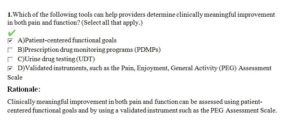1.Which of the following tools can help providers determine clinically meaningful improvement in both pain and function? (Select all that apply.)
A)Patient-centered functional goals
B)Prescription drug monitoring programs (PDMPs)
C)Urine drug testing (UDT)
D)Validated instruments, such as the Pain, Enjoyment, General Activity (PEG) Assessment Scale
2.
Which of the following practices may be used to assess patient risk factors for opioid therapy? (Select all that apply.)
A)Detailed medical and family history review
B)Physical examination
C)DSM- 5 Opioid Use Disorder (OUD) checklist
D)Urine drug testing (UDT)
3.
Which of the following statement(s) are TRUE about the risks of opioid therapy? (Select all that apply.)
A)Although opioids can reduce pain in the short-term, benefits for pain relief, function, and quality of life with long-term opioid use for chronic pain are uncertain.
B)Opioids should not be considered first-line or routine therapy for chronic pain given the small to moderate short-term benefits, uncertain long-term benefits, and potential for serious harms.
C)Opioid therapy should be considered only in cases where you believe it will offer benefits in improved pain relief and function that outweigh the significant risks to the patient.
D)Combining nonpharmacologic and nonopioid therapies are not ideal for treating chronic pain and do not enhance effectiveness.
4.
Before initiating opioid therapy with a patient, what steps should be completed? (Select all that apply.)
A)Establish treatment goals with your patient.
B)Consider what dosage is needed to eliminate the patient’s pain completely.
C)Determine how effectiveness will be evaluated.
D)Outline a clear strategy for discontinuing opioid therapy if it isn’t successful.
5.
Which of the following assessment tools may be used to identify undisclosed substance use disorder (SUD)? (Select all that apply.)
A)Urine drug testing (UDT)
B)Substance use screening and assessment tools
C)Differential Pain, Enjoyment, General Activity (PEG) assessment
D)Prescription drug monitoring program (PDMP)
Solution:

To access the solution click the icon below to purchase at $10